ZrO2 Nanoparticles and Poly(diallyldimethylammonium chloride)-Doped Graphene Oxide Aerogel-Coated Stainless-Steel Mesh for the Effective Adsorption of Organophosphorus Pesticides
Abstract
:1. Introduction
2. Materials and Methods
2.1. Materials and Reagents
2.2. Apparatus
2.3. Preparation of Adsorption Materials
2.4. Sample Preparation and Extraction Procedure
2.5. Adsorption Experiment
3. Results
3.1. Characterization of the Sorbent
3.2. Interaction Energy
3.3. Optimization of the Extraction Procedure
3.3.1. Extraction Conditions
3.3.2. Desorption Conditions
3.4. Extraction Performance and Extraction Mechanism
3.5. Evaluation of the Method
3.6. Stability and Lifetime
3.7. Application in Real Sample
4. Conclusions
Supplementary Materials
Author Contributions
Funding
Conflicts of Interest
References
- Teodoro, M.; Briguglio, G.; Fenga, C.; Costa, C. Genetic polymorphisms as determinants of pesticide toxicity: Recent advances. Toxicol. Rep. 2019, 6, 564–570. [Google Scholar] [CrossRef]
- Yang, F.W.; Li, J.W.; Pang, G.F.; Ren, F.Z.; Fang, B. Effects of diethyl phosphate, a non-specific metabolite of organophosphorus pesticides, on serum lipid, hormones, inflammation, and gut microbiota. Molecules 2019, 24, 2003. [Google Scholar] [CrossRef] [PubMed] [Green Version]
- Wang, J.W.; Teng, Y.G.; Zhang, C.X.; Liao, X.P.; Zhai, Y.Z.; Zuo, R. Activation of manganese dioxide with bisulfite for enhanced abiotic degradation of typical organophosphorus pesticides: Kinetics and transformation pathway. Chemosphere 2019, 226, 858–864. [Google Scholar] [CrossRef] [PubMed]
- Huang, X.C.; Ma, J.K.; Feng, R.X.; Wei, S.L. Simultaneous determination of five organophosphorus pesticide residues in different food samples by solid-phase microextraction fibers coupled with high-performance liquid chromatography. J. Sci. Food Agric. 2019, 99, 6998–7007. [Google Scholar] [CrossRef] [PubMed]
- Lu, D.K.; Liu, C.; Deng, J.K.; Zhou, X.G.; Shi, G.Y.; Zhou, T.S. Rational design of an ionic liquid dispersive liquid–liquid micro-extraction method for the detection of organophosphorus pesticides. Analyst 2019, 144, 2166–2172. [Google Scholar] [CrossRef] [PubMed]
- González-Curbelo, M.Á.; Hernández-Borges, J.; Borges-Miquel, T.M.; Rodríguez-Delgado, M.Á. Determination of organophosphorus pesticides and metabolites in cereal-based baby foods and wheat flour by means of ultrasound-assisted extraction and hollow-fiber liquid-phase microextraction prior to gas chromatography with nitrogen phosphorus detection. J. Chromatogr. A 2013, 1313, 166–174. [Google Scholar] [CrossRef]
- Kermani, M.; Jafari, M.T.; Saraji, M. Porous magnetized carbon sheet nanocomposites for dispersive solid-phase microextraction of organophosphorus pesticides prior to analysis by gas chromatography-ion mobility spectrometry. Microchim. Acta 2019, 186, 88. [Google Scholar] [CrossRef]
- Zohrabi, P.; Shamsipur, M.; Hashemi, M.; Hashemi, B. Liquid-phase microextraction of organophosphorus pesticides using supramolecular solvent as a carrier for ferrofluid. Talanta 2016, 160, 340–346. [Google Scholar] [CrossRef]
- Manafi Khoshmanesh, S.; Hamishehkar, H.; Razmi, H. Trace analysis of organophosphorus pesticide residues in fruit juices and vegetables by an electrochemically fabricated solid-phase microextraction fiber coated with a layer-by-layer graphenized graphite/graphene oxide/polyaniline nanocomposite. Anal. Methods 2020, 12, 3268–3276. [Google Scholar] [CrossRef] [PubMed]
- Zeng, J.B.; Li, Y.L.; Zheng, X.F.; Li, Z.Z.; Zeng, T.; Duan, W.; Li, Q.; Shang, X.; Dong, B. Controllable transformation of aligned ZnO nanorods to ZIF-8 as solid-phase microextraction coatings with tunable porosity, polarity, and conductivity. Anal. Chem. 2019, 91, 5091–5097. [Google Scholar] [CrossRef]
- Qin, P.G.; Zhu, W.L.; Han, L.Z.; Zhang, X.W.; Zhao, B.; Zhang, X.B.; Lu, M.H. Monodispersed mesoporous SiO2@metal-organic framework (MSN@MIL-101(Fe)) composites as sorbent for extraction and preconcentration of phytohormones prior to HPLC-DAD analysis. Microchim. Acta 2020, 187, 367. [Google Scholar] [CrossRef]
- Lin, X.P.; Wang, X.Q.; Wang, J.; Yuan, Y.W.; Di, S.S.; Wang, Z.W.; Xu, H.; Zhao, H.Y.; Zhao, C.S.; Ding, W.; et al. Magnetic covalent organic framework as a solid-phase extraction absorbent for sensitive determination of trace organophosphorus pesticides in fatty milk. J. Chromatogr. A 2020, 1627, 461387. [Google Scholar] [CrossRef] [PubMed]
- Du, L.Y.; Wang, X.D.; Liu, T.T.; Li, J.Y.; Wang, J.X.; Gao, M.; Wang, H.L. Magnetic solid-phase extraction of organophosphorus pesticides from fruit juices using NiFe2O4@polydopamine@Mg/Al-layered double hydroxides nanocomposites as an adsorbent. Microchem. J. 2019, 150, 104128. [Google Scholar] [CrossRef]
- Mehdipour, M.; Ansari, M.; Pournamdari, M.; Zeidabadinejad, L.; Kazemipour, M. Selective extraction of malathion from biological fluids by molecularly imprinted polymer coated on spinel ZnFe2O4 magnetic nanoparticles based on green synthesis. Sep. Sci. Technol. 2020, 56, 1899–1909. [Google Scholar] [CrossRef]
- Zhang, J.; Li, W.Q.; Zhu, W.L.; Yang, Y.X.; Qin, P.G.; Zhou, Q.; Lu, M.H.; Cai, Z.W. Mesoporous graphitic carbon nitride as an efficient sorbent for extraction of sulfonamides prior to HPLC analysis. Microchim. Acta 2019, 186, 279. [Google Scholar] [CrossRef] [PubMed]
- Yang, Y.X.; Qin, P.G.; Zhang, J.; Li, W.Q.; Zhu, J.H.; Lu, M.H.; Cai, Z.W. Fabrication of nanoscale graphitic carbon nitride/copper oxide hybrid composites coated solid-phase microextraction fibers coupled with gas chromatography for determination of polycyclic aromatic hydrocarbons. J. Chromatogr. A 2018, 1570, 47–55. [Google Scholar] [CrossRef] [PubMed]
- Feng, J.J.; Loussala, H.M.; Han, S.; Ji, X.P.; Li, C.Y.; Sun, M. Recent advances of ionic liquids in sample preparation. TrAC Trends Anal. Chem. 2020, 125, 115833. [Google Scholar] [CrossRef]
- Tian, Y.; Feng, J.J.; Wang, X.Q.; Luo, C.N.; Sun, M. Ionic liquid-functionalized silica aerogel as coating for solid-phase microextraction. J. Chromatogr. A 2019, 1583, 48–54. [Google Scholar] [CrossRef]
- Feng, J.J.; Wang, X.Q.; Han, S.; Ji, X.P.; Li, C.Y.; Luo, C.N.; Sun, M. An ionic-liquid-modified melamine-formaldehyde aerogel for in-tube solid-phase microextraction of estrogens followed by high performance liquid chromatography with diode array detection. Microchim. Acta 2019, 186, 769. [Google Scholar] [CrossRef]
- Amiri, A.; Ghaemi, F. Graphene grown on stainless steel mesh as a highly efficient sorbent for sorptive microextraction of polycyclic aromatic hydrocarbons from water samples. Anal. Chim. Acta 2017, 994, 29–37. [Google Scholar] [CrossRef]
- Hu, H.; Zhao, Z.B.; Wan, W.B.; Gogotsi, Y.; Qiu, J.S. Ultralight and highly compressible graphene aerogels. Adv. Mater. 2013, 25, 2219–2223. [Google Scholar] [CrossRef]
- Zhao, J.; Zhang, Y.Z.; Chen, J.Y.; Zhang, W.L.; Yuan, D.; Chua, R.; Alshareef, H.N.; Ma, Y.W. Codoped holey graphene aerogel by selective etching for high-performance sodium-ion storage. Adv. Energy Mater. 2020, 10, 2000099. [Google Scholar] [CrossRef]
- Han, Q.; Yang, L.; Liang, Q.L.; Ding, M.Y. Three-dimensional hierarchical porous graphene aerogel for efficient adsorption and preconcentration of chemical warfare agents. Carbon 2017, 122, 556–563. [Google Scholar] [CrossRef]
- Tang, S.; Sun, J.; Xia, D.; Zang, B.; Gao, Y.; Chen, C.; Shen, W.; Lee, H.K. In-syringe extraction using compressible and self-recoverable, amphiphilic graphene aerogel as sorbent for determination of phenols. Talanta 2019, 195, 165–172. [Google Scholar] [CrossRef] [PubMed]
- Wu, Q.; Wu, W.; Zhan, X.; Hou, X.D. Three-dimensional chitosan/graphene oxide aerogel for high-efficiency solid-phase extraction of acidic herbicides in vegetables. New J. Chem. 2020, 44, 10654–10661. [Google Scholar] [CrossRef]
- Zhao, M.H.; Reda, A.T.; Zhang, D.X. Reduced graphene oxide/ZIF-67 aerogel composite material for uranium adsorption in aqueous solutions. ACS Omega 2020, 5, 8012–8022. [Google Scholar] [CrossRef] [Green Version]
- Sharma, B.; Thakur, S.; Trache, D.; Nezhad, H.Y.; Thakur, V.K. Microwave-assisted rapid synthesis of reduced graphene oxide-based gum tragacanth hydrogel nanocomposite for heavy metal ions adsorption. Nanomaterials 2020, 10, 1616. [Google Scholar] [CrossRef] [PubMed]
- Arabkhani, P.; Asfaram, A. Development of a novel three-dimensional magnetic polymer aerogel as an efficient adsorbent for malachite green removal. J. Hazard. Mater. 2020, 384, 121394. [Google Scholar] [CrossRef]
- Huangfu, Y.M.; Ruan, K.P.; Qiu, H.; Lu, Y.J.; Liang, C.B.; Kong, J.; Gu, J.W. Fabrication and investigation on the PANI/MWCNT/thermally annealed graphene aerogel/epoxy electromagnetic interference shielding nanocomposites. Compos. Part A Sci. Manuf. 2019, 121, 265–272. [Google Scholar] [CrossRef]
- Bai, R.X.; Yang, F.; Meng, L.Y.; Zhao, Z.G.; Guo, W.H.; Cai, C.Q.; Zhang, Y. Polyethylenimine functionalized and scaffolded graphene aerogel and the application in the highly selective separation of thorium from rare earth. Mater. Des. 2021, 197, 109195. [Google Scholar] [CrossRef]
- Hou, X.D.; Yu, H.; Yan, S.H.; Xiao, J.X.; Sun, M.; Wu, W. Cationic polyelectrolyte/graphene oxide as an efficient sorbent for the extraction and analysis of trace acidic herbicides in vegetables. J. Chromatogr. A 2020, 1618, 460884. [Google Scholar] [CrossRef]
- Tong, Z.B.; Xu, M.Q.; Li, Q.; Liu, C.; Wang, Y.L.; Sha, J.Q. Polyelectrolyte-functionalized reduced graphene oxide wrapped helical POMOF nanocomposites for bioenzyme-free colorimetric biosensing. Talanta 2020, 220, 121373. [Google Scholar] [CrossRef]
- Tian, J.M.; Mu, Z.D.; Wang, J.; Zhou, J.; Yuan, Y.H.; Bai, L.J. Electrochemical aptasensor for ultrasensitive detection of lipopolysaccharide using silver nanoparticles decorated titanium dioxide nanotube/functionalized reduced graphene oxide as a new redox nanoprobe. Microchim. Acta 2021, 188, 31. [Google Scholar] [CrossRef] [PubMed]
- Rahbar, N.; Behrouz, E.; Ramezani, Z. One-step synthesis of zirconia and magnetite nanocomposite immobilized chitosan for micro-solid-phase extraction of organophosphorous pesticides from juice and water samples prior to gas chromatography/mass spectroscopy. Food Anal. Method 2017, 10, 2229–2240. [Google Scholar] [CrossRef]
- Kweon, H.K.; Håkansson, K. Selective zirconium dioxide-based enrichment of phosphorylated peptides for mass spectrometric analysis. Anal. Chem. 2006, 78, 1743–1749. [Google Scholar] [CrossRef] [PubMed]
- Liu, A.J.; Kou, W.; Zhang, H.; Xu, J.Q.; Zhu, L.X.; Kuang, S.L.; Huang, K.K.; Chen, H.W.; Jia, Q. Quantification of trace organophosphorus pesticides in environmental water via enrichment by magnetic-zirconia nanocomposites and online extractive electrospray ionization mass spectrometry. Anal. Chem. 2020, 92, 4137–4145. [Google Scholar] [CrossRef]
- Gannavarapu, K.P.; Ganesh, V.; Thakkar, M.; Mitra, S.; Dandamudi, R.B. Nanostructured diatom-ZrO2 composite as a selective and highly sensitive enzyme free electrochemical sensor for detection of methyl parathion. Sens. Actuators B Chem. 2019, 288, 611–617. [Google Scholar] [CrossRef] [PubMed]
- Zare, M.; Ramezani, Z.; Rahbar, N. Development of zirconia nanoparticles-decorated calcium alginate hydrogel fibers for extraction of organophosphorous pesticides from water and juice samples: Facile synthesis and application with elimination of matrix effects. J. Chromatogr. A 2016, 1473, 28–37. [Google Scholar] [CrossRef]
- Hou, X.D.; Liu, S.J.; Zhou, P.P.; Li, J.; Liu, X.; Wang, L.C.; Guo, Y. Polymeric ionic liquid modified graphene oxide-grafted silica for solid-phase extraction to analyze the excretion-dynamics of flavonoids in urine by Box-Behnken statistical design. J. Chromatogr. A 2016, 1456, 10–18. [Google Scholar] [CrossRef]



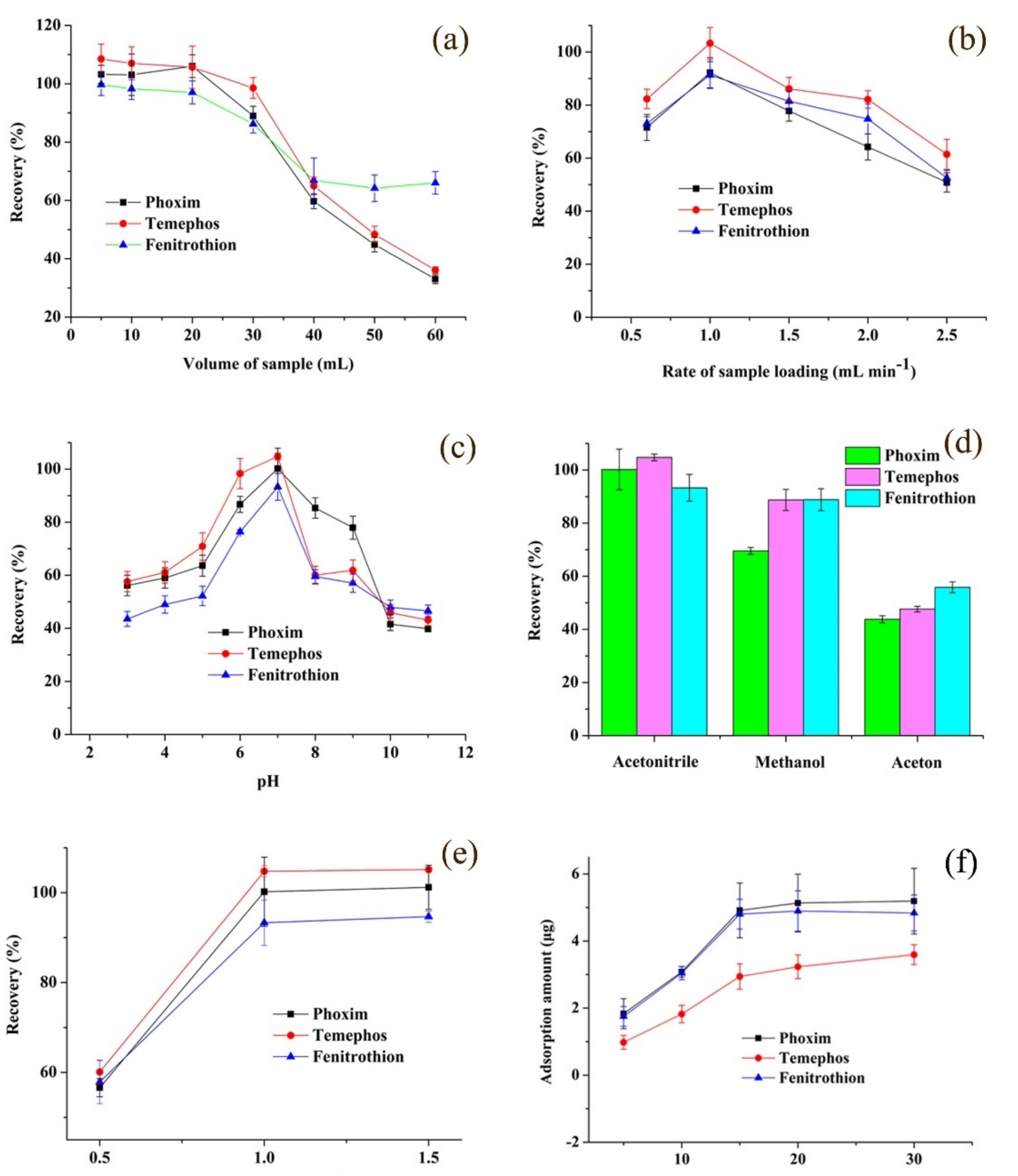
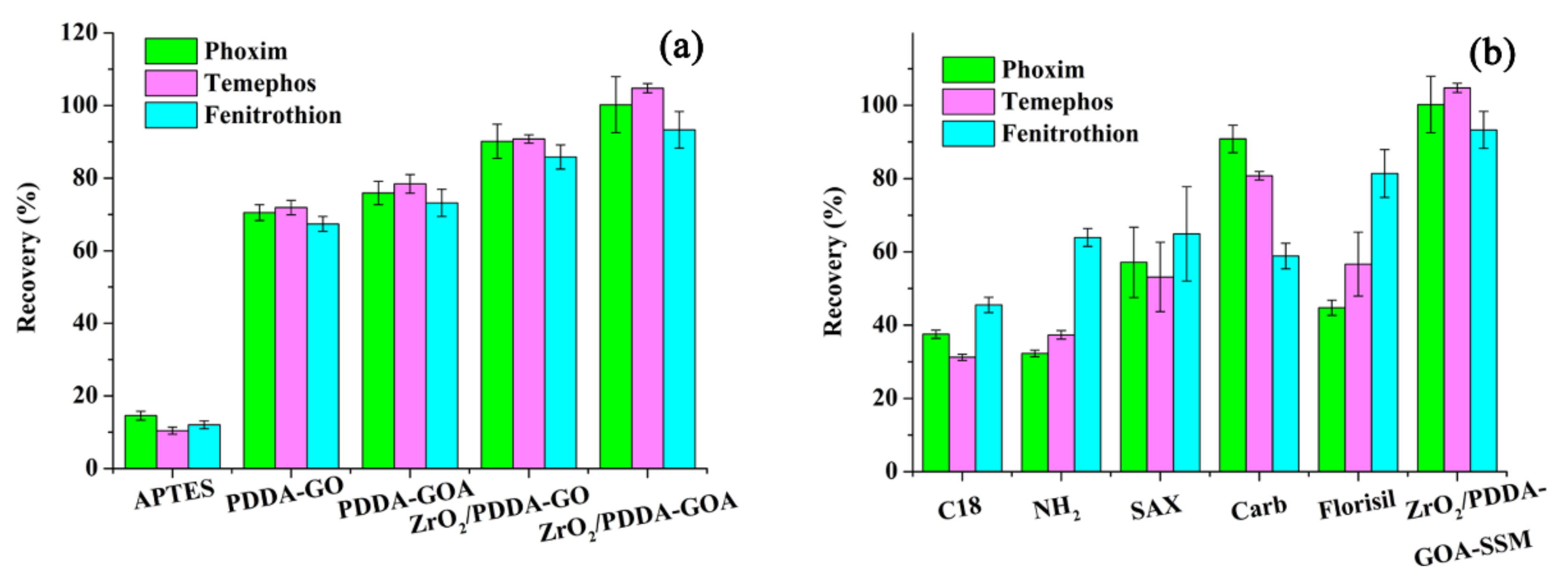
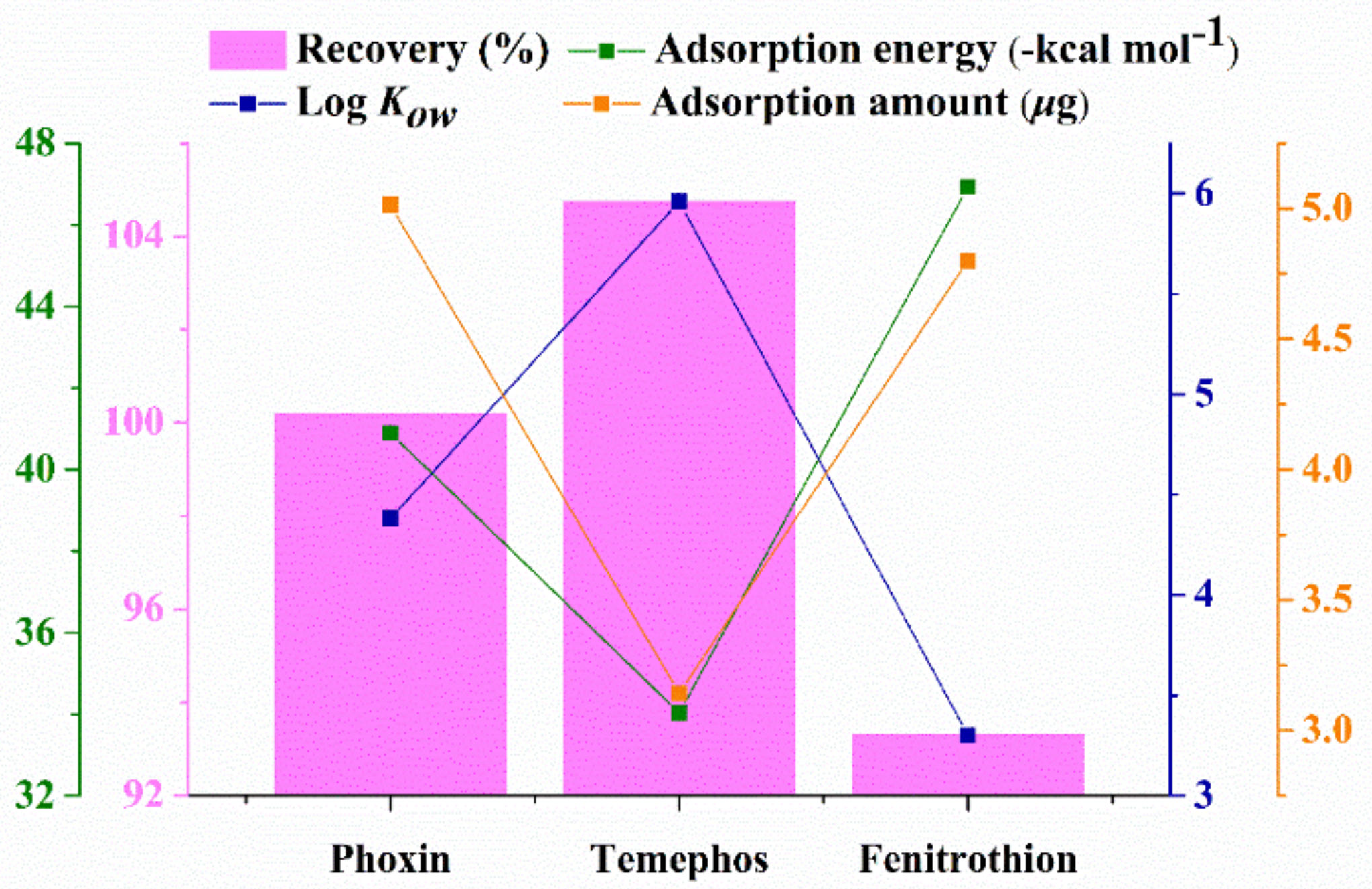
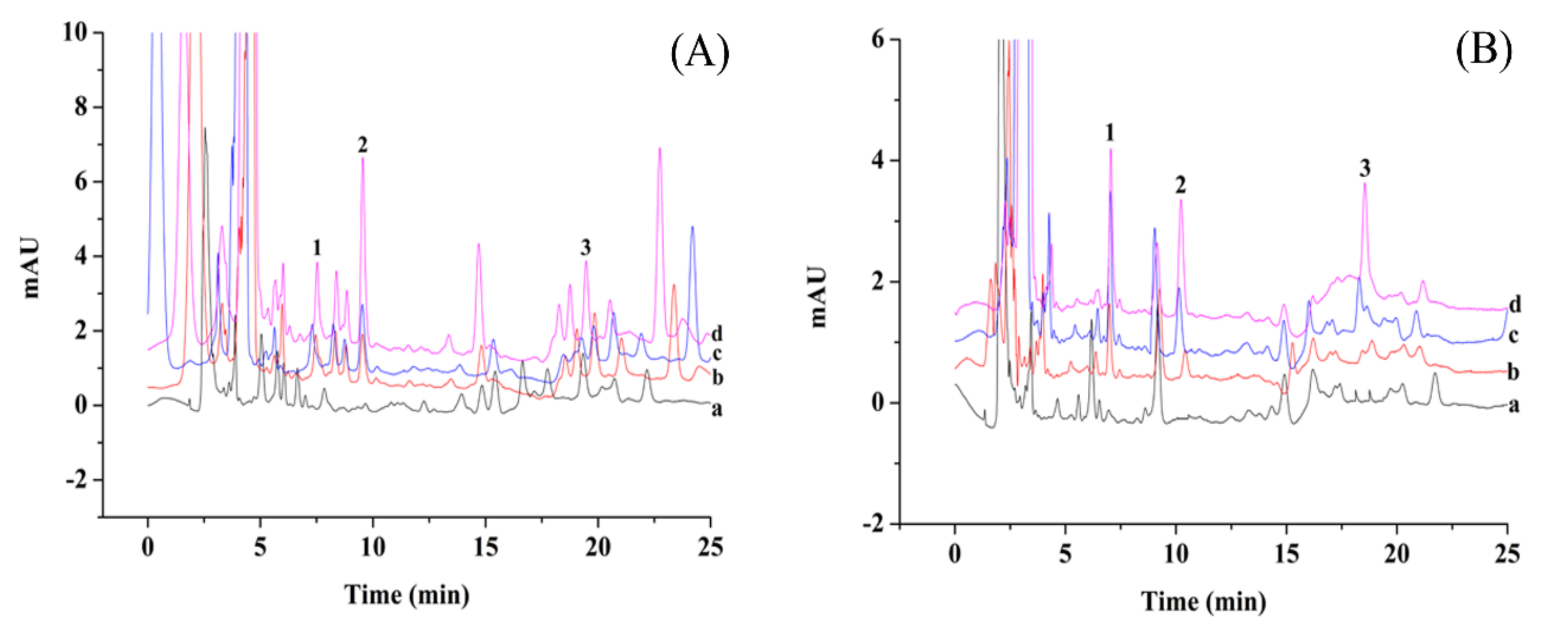
| Analyte | Structure | ΔHF (kcal mol−1) | ΔG (kcal mol−1) | Log Kow |
|---|---|---|---|---|
| Phoxin | 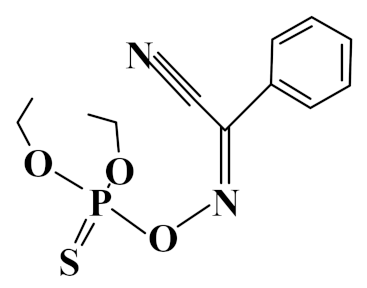 | −40.9 | −26.0 | 4.4 |
| Temephos | 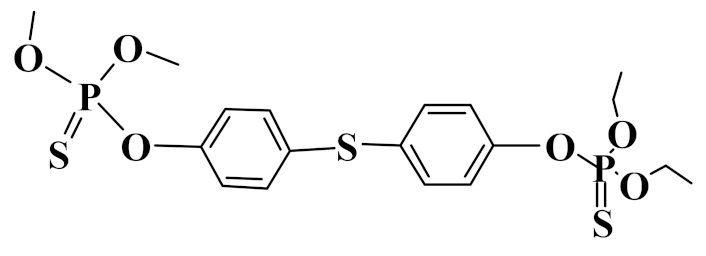 | −34.0 | −20.3 | 5.9 |
| Fenitrothion | 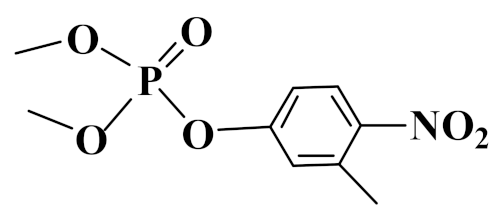 | −46.9 | −32.4 | 3.3 |
| Compound | Linear Equation | Linear Range (μg L−1) | R a | EF b | LOQ c (μg L−1) | LOD d (μg L−1) | Repeatability (RSD e, n = 5, %) | Reproducibility (RSD, n = 5, %) |
|---|---|---|---|---|---|---|---|---|
| Phoxim | y = 0.2329x + 0.2541 | 1–200 | 0.9952 | 20.0 | 1 | 0.5 | 7.6 | 10.1 |
| Temephos | y = 0.2571x + 0.3962 | 2.5–200 | 0.9964 | 20.9 | 2.5 | 1.0 | 1.3 | 8.5 |
| Fenitrothion | y = 0.1983x + 0.1864 | 1–200 | 0.9990 | 18.7 | 1 | 0.2 | 5.0 | 6.4 |
| Compound | Added (µg g−1) | Pak Choi | Chives | ||
|---|---|---|---|---|---|
| Recovery (%) | RSD (n = 3, %) | Recovery (%) | RSD (n = 3, %) | ||
| Phoxim | 20 | 51.3 | 1.2 | 67.0 | 4.4 |
| 40 | 69.8 | 5.3 | 92.7 | 8.3 | |
| 100 | 52.5 | 0.6 | 80.6 | 15.0 | |
| Temephos | 20 | 91.9 | 0.6 | 71.7 | 6.0 |
| 40 | 83.5 | 2.9 | 86.2 | 2.9 | |
| 100 | 91.8 | 5.3 | 63.8 | 2.0 | |
| Fenitrothion | 20 | 80.3 | 5.5 | 53.6 | 3.4 |
| 40 | 81.9 | 4.9 | 66.9 | 2.7 | |
| 100 | 78.9 | 1.8 | 73.4 | 2.2 | |
Publisher’s Note: MDPI stays neutral with regard to jurisdictional claims in published maps and institutional affiliations. |
© 2021 by the authors. Licensee MDPI, Basel, Switzerland. This article is an open access article distributed under the terms and conditions of the Creative Commons Attribution (CC BY) license (https://creativecommons.org/licenses/by/4.0/).
Share and Cite
Hou, X.; Ding, R.; Yan, S.; Zhao, H.; Yang, Q.; Wu, W. ZrO2 Nanoparticles and Poly(diallyldimethylammonium chloride)-Doped Graphene Oxide Aerogel-Coated Stainless-Steel Mesh for the Effective Adsorption of Organophosphorus Pesticides. Foods 2021, 10, 1616. https://doi.org/10.3390/foods10071616
Hou X, Ding R, Yan S, Zhao H, Yang Q, Wu W. ZrO2 Nanoparticles and Poly(diallyldimethylammonium chloride)-Doped Graphene Oxide Aerogel-Coated Stainless-Steel Mesh for the Effective Adsorption of Organophosphorus Pesticides. Foods. 2021; 10(7):1616. https://doi.org/10.3390/foods10071616
Chicago/Turabian StyleHou, Xiudan, Rong Ding, Shihai Yan, Haiyan Zhao, Qingli Yang, and Wei Wu. 2021. "ZrO2 Nanoparticles and Poly(diallyldimethylammonium chloride)-Doped Graphene Oxide Aerogel-Coated Stainless-Steel Mesh for the Effective Adsorption of Organophosphorus Pesticides" Foods 10, no. 7: 1616. https://doi.org/10.3390/foods10071616
APA StyleHou, X., Ding, R., Yan, S., Zhao, H., Yang, Q., & Wu, W. (2021). ZrO2 Nanoparticles and Poly(diallyldimethylammonium chloride)-Doped Graphene Oxide Aerogel-Coated Stainless-Steel Mesh for the Effective Adsorption of Organophosphorus Pesticides. Foods, 10(7), 1616. https://doi.org/10.3390/foods10071616






